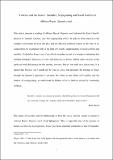"Violence and the Sacred": sacrifice, scapegoating and social conflict in Alfonso Reyes Ifigenia cruel
Date
2016-10-24Author
Shaughnessy, Lorna
Metadata
Show full item recordUsage
This item's downloads: 868 (view details)
Cited 2 times in Scopus (view citations)
Recommended Citation
Shaughnessy, Lorna. (2016). “Violence and the Sacred”: sacrifice, scapegoating and social conflict in Alfonso Reyes’ Ifigenia cruel. Classical Receptions Journal, 9(3), 379-399. doi: 10.1093/crj/clw022
Published Version
Abstract
This article presents a reading of Alfonso Reyes Ifigenia cruel informed by René Girard s theories of mimetic violence and the scapegoating effect . It seeks to foster interest in the complex relationship between the play and the Mexican political context at the time of its composition, by examining both in the light of Girard s understanding of social conflict and sacrifice. It identifies Reyes use of sacrificial metaphor as part of a complex continuum that includes Euripides Iphigenia in Aulis and Iphigenia in Tauris. Where older versions of the myth end with deliverance for the heroine, however, Reyes text ends on a darker note. It is argued that Ifigenia cruel should not be read as a text that promotes the triumph of peace through the heroine s rejection of her past, but rather as one where self-sacrifice and the shadow of scapegoating, as understood by Girard, reflect a Mexico racked by continuing violence.


